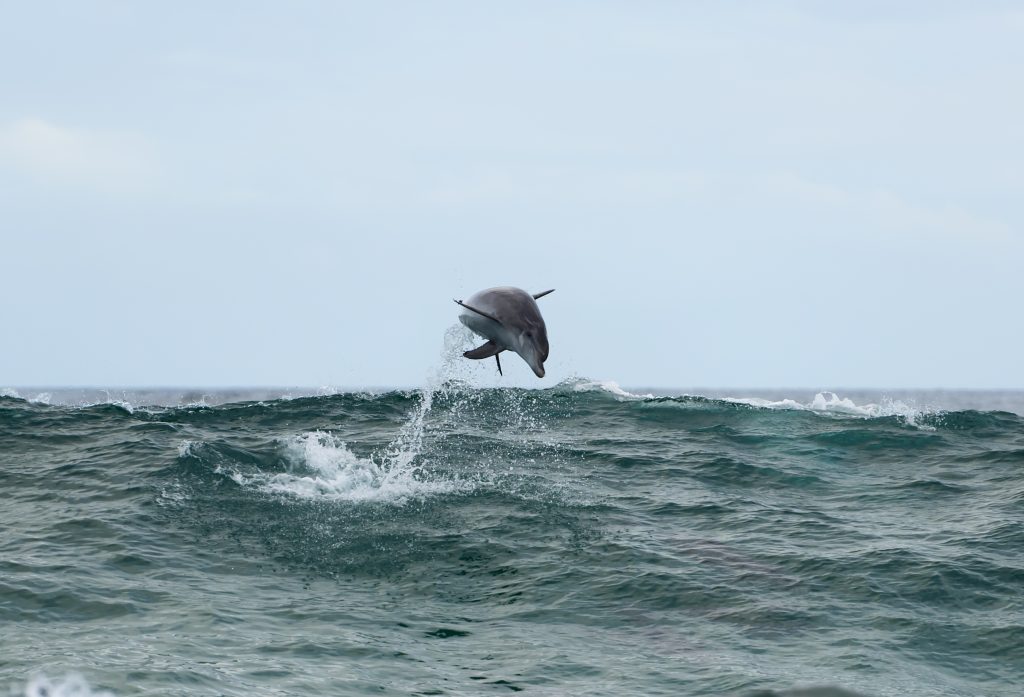
Bottlenose dolphins that died of sepsis in San Diego may be linked to the Tijuana sewage crisis, researchers say.
“These dolphins serve as sentinels for the risk of possible human exposures to dangerous bacteria,” a new white paper from San Diego State University’s School of Public Health reads.
The report, published by San Diego State University’s School of Public Health, calls the issue a “pressing public health crisis” due to “potential health risks to surrounding communities from harmful viruses, bacteria, and parasites, as well as toxic chemicals in water and air.”
The study came at the request of Congress Member Scott Peters, who said that by substantiating the impact the sewage crisis has in local communities, he hopes to urge Congress to allocate the additional needed funding to stop the flow of sewage from Tijuana into coastal waters.
In it, researchers quantified levels of contamination in the air, soil, and water in effort to understand how untreated sewage spilling from Tijuana into the ocean is impacting the local environment.
Researchers reviewed more than 60 studies to compile the results of their paper, which outlines contaminants found in the air, soil, and water.
In addition to the public health implications of contaminated air, water, and soil, other less obvious impacts could arise, said Paula Stigler Granados, associate professor in SDSU’s School of Public Health, and the paper’s lead author. Those include contamination of seafood, algal blooms, and impacts on marine life.
For example, there has been an increase in stranded dolphins in San Diego, and the paper suggests their illnesses and subsequent deaths could be caused by exposure to contaminated water.
The International Boundary and Water Commission has reported that over 100 billion gallons of untreated sewage, industrial waste, and urban runoff have spilled into the Tijuana Estuary and the Pacific Ocean via the Tijuana River and its tributaries over the last five years.
“The fact that there has been a problem here has been painfully obvious to the community for a long time,” said Greg Oliphant, CEO of Prebys Foundation, which commissioned the paper. “It has been treated by folks who are in the position to do something about it almost as a side issue, acknowledging the environmental consequences, but never looking more deeply at the impact it’s having on the ground in the community.”
However, the paper says, more monitoring and research is needed.
“The documented presence in the Tijuana River and Estuary of toxic chemicals and human and animal pathogens, especially antibiotic resistant pathogens, demands urgent attention,” the paper concludes. “Monitoring for a wide suite of chemicals and microbes in the water and air is necessary to characterize the risks and geographic extent of contamination to our region.”
‘If you’ve been to the area, you know the smell.’
Peters said that spending time on research is a crucial strategy in securing requisite funding to solve the sewage crisis.
“We really need to get Congress to approve this money,” he said. “It’s important to gather evidence that drives home the severity of the problem.”
Peters said he is already using the paper’s findings to make a case for more sewage funding. This month, he also asked the U.S. Navy to provide more information about how contaminated waters impact Navy SEALs training in Coronado.
After declaring an emergency in June 2023, the San Diego County Board of Supervisors directed staff to prepare an economic impact report detailing how the crisis is affecting business. That report was expected last fall, but has not yet been released.
Meanwhile, the California Coastal Commission asked San Diego County to look into health implications of the sewage problem after doctors attended an October meeting and said they had seen an increase in gastrointestinal related urgent care visits in Imperial Beach.
“We’re trying to illustrate a problem that’s 3,000 miles away from Washington, D.C.,” Peters said. “If this were in the Chesapeake Bay or even the Great Lakes, it wouldn’t be so obscure to people. So this evidence is really important.”
Peters said he believes he has enough research to back the need for funding – a need he says that Imperial Beach and other South Bay communities already know well.
“If you’ve been to the area, you know the smell,” Peters said.
Imperial Beach Mayor Paula Aguirre, another vocal player in the push for additional sewage funding, said she experienced “broad support” for the funding request when she led a bipartisan delegation to the capital earlier this month.
“This is unsustainable,” she said. “We need solutions. Not in five years, not in 10 years, but as soon as possible.”




